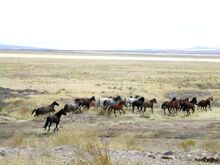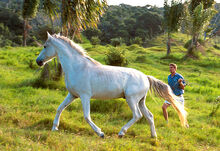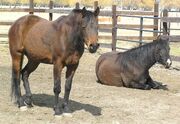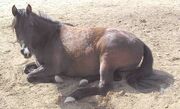Assessment |
Biopsychology |
Comparative |
Cognitive |
Developmental |
Language |
Individual differences |
Personality |
Philosophy |
Social |
Methods |
Statistics |
Clinical |
Educational |
Industrial |
Professional items |
World psychology |
Animals · Animal ethology · Comparative psychology · Animal models · Outline · Index
Horse behavior is best understood from the perspective that horses are prey animals with a well-developed fight-or-flight instinct. Their first response to a threat is to flee, although they are known to stand their ground and defend themselves or their offspring in cases where flight is not possible, such as when a foal would be threatened.
Nonetheless, because their physiology is also suited to the accomplishment of a number of work- and entertainment-related tasks, humans domesticated horses thousands of years ago and they have served humans ever since. Through selective breeding, some breeds of horses have been bred to be quite docile, particularly certain large draft horses. On the other hand, most light horse riding breeds were developed for speed, agility, alertness and endurance; building on natural qualities that extended from their wild ancestors.
The instincts of horses can be used to human advantage to create a bond between human and horse. These techniques vary, but are part of the art of horse training.
Horses as herd animals[]

Free-roaming mustangs (Utah, 2005)
Horses are highly social herd animals that prefer to live in a group. Like all creatures, equine social behavior developed to help the species survive.
Horses are able to form companionship attachments not only to their own species, but with other animals, including humans. In fact, manydomesticated horses will become anxious, flighty and hard to manage if they are isolated. Horses kept in near-complete isolation, particularly in a closed stable where they cannot see other animals may require a stable companion such as a cat, goat or even a small pony or donkey to provide company and reduce stress.
When anxiety over separation occurs while a horse is being handled by human, the horse is called being "herd-bound". However, through proper training, horses learn to be comfortable away from other horses, often because they learn to trust a human handler, essentially ranking humans as a dominant member of a "herd."
Herd behavior in the wild[]
Feral and wild horse herds are usually made up of small bands led by a dominant mare, containing additional mares, their foals, and immature horses of both sexes. There is usually one herd stallion, though occasionally a few less-dominant males may remain with the group.
Horse "herds" in the wild are best described as groups of several small bands who share a common territory. Bands are usually on the small side, as few as three to five animals, but sometimes over a dozen. The makeup of bands shifts over time as young animals are driven out of the band they were born into and join other bands, or as young stallions challenge older males for dominance. However, in a given closed ecosystem such as the isolated refuges in which most wild horses live today, to maintain genetic diversity the minimum size for a sustainable wild horse or burro population is 150-200 animals.[1]
Hierarchical structure[]
Survival dictates that the herd members ultimately cooperate and stick together. As with many animals that live in large groups, establishment of a stable hierarchy or "pecking order" is important to smooth group functioning. Contention for dominance can be risky since one well-placed kick to a leg could cripple another horse to such an extent that it would be defenseless, exposed, and possibly unable to get to food or water. Therefore, another job of higher-ranked animals is to exercise control and moderate aggressive behavior in the herd.
In times of stress, whether from predators or extreme weather, the center of the herd is the safest because it offers the most protection from the elements and is further away from predators than any other part. Because of this, "punishment" of misbehaving members is sometimes delivered in the form of expulsion from the herd--temporarily or sometimes permanently.
Most young horses in the wild are allowed to stay with the herd until sometime in their yearling or 2-year old year, when they reach full sexual maturity. Studies of wild herds have shown that the herd stallion will usually drive out both young colts and fillies. This probably is an instinct that prevents inbreeding, so that the herd stallion does not mate with his own female offspring. The fillies usually join another band in fairly short order, and the young colts driven out from various herds usually join together for safety in small "bachelor" groups until they are each able to establish dominance over an older stallion in another herd.
Role of the lead mare[]
Contrary to human anthropomorphism, the traditionally portrayed the dominant stallion as the ruler of a "harem" of females, the actual leader of a wild or feral herd is the alpha or dominant mare, commonly known as the "boss mare" or "lead mare." She is usually one of the more mature animals, responsible for the overall safety of the herd, familiar with the terrain and resources available. She takes the lead when the herd travels, determines the best route, when to move from one place to another, and claims the right to drink first from watering holes and stake out the best location for grazing.
Role of the herd stallion[]
As a rule, the edge of the herd is where the lowest animals in the herd's social order are found, but also is the domain of the herd stallion, who must fight off both predators and other males. When the herd travels, the stallion brings up the rear, watching for predators and driving straggling herd members on, keeping the group together. By living on the periphery of the herd, exposed to weather, predators, and other risks, the herd stallion endures a somewhat vulnerable existence. His value to the herd exists only as long as he is healthy and can retain his dominance. Because there are generally younger, unattached stallions about, he can be challenged and replaced by a stronger successor at any time.
Interestingly, a herd stallion will occasionally tolerate one young stallion to live at the edge of the herd, possibly as a sort of designated successor, even though the young horse will eventually gain mastery over the older stallion and claim the herd.
Ratio of stallions and mares[]
Biologically, and depending on the physical environment available to a herd in the wild, there is only a need for one stallion for every 10 to 20 mares, though most bands are smaller than this. Domesticated stallions, with careful human management, often "cover" more mares in a year than is possible in the wild. Traditionally, Thoroughbred stud farms limited stallions to breeding between 40 and 60 mares a year. Today, by carefully breeding mares only when at the peak of their Estrous cycle, a few thoroughbred stallions have "covered" over 200 mares per year. With use of technologies such as artificial insemination one stallion could sire thousands of offspring annually, though in actual practice, economic considerations usually limit the number of foals produced.[2]
Domesticated stallion behavior[]
- Main article: Horse breeding
Some horse breeders keep horses in semi-natural conditions, allowing a single stallion to run with a group of mares referred to as "pasture breeding," and keep young stallions who are not of breeding age in a separate "bachelor herd." While this has advantages of less intensive labor for human caretakers, and full time turnout may be psychologically healthy for the horses, pasture breeding presents a risk of injury to valuable breeding stock, both stallions and mares, particularly when unfamiliar animals are added to the herd. It also raises questions of when or if a mare is bred, and may also raise questions as to parentage of ensuing foals. Thus, keeping stallions in a natural herd is not particularly common, especially on breeding farms standing multiple stallions to outside mares. It is more often seen on farms with closed herds; only one or a few stallions with a stable mare herd and few, if any, outside mares.
More often, mature domesticated stallions are commonly kept by themselves in a stable or small paddock with a strong, high fence that prevents escape.
When multiple stallions, especially animals who are unfamiliar to each other, are stabled together, such as at large breeding farms, horse shows or at a racetrack, they are usually kept from smelling or touching one another. If they have access to paddocks, there often is a corridor between the paddocks so the stallions cannot touch or sniff one another. Stallions are often kept well away from mares as well, except when breeding, both to avoid unintentional or unplanned matings, but also to minimize their instincts to fight one another for dominance when in the presence of mares.
However, even stallions have a need for social contact with other creatures, and isolation can lead to stable vices. To alleviate this problem, some stallions, though not all, do well when stabled with a non-horse companion, such as a gelded donkey or a goat. (The Godolphin Arabian was said to be particularly fond of a barn cat). While many domesticated stallions become too aggressive to tolerate the close presence of any other male horse without fighting, some tolerate a gelding as a companion, particularly one that has a very calm, unflappable temperament. One example of this was the racehorse Seabiscuit, who lived with a gelding companion named "Pumpkin." Other stallions may tolerate the close presence of an immature and thus less dominant stallion.
When stallions are stabled in such a way that they can both see each other and touch nose to nose, such as through bars or a grill, they will challenge one another. Strange stallions are not stabled in this fashion due to risk of injury and disruption to the rest of the stable. However, some farms feel that social contact benefits stallions and with careful management can keep generally well-tempered stallions who will be kept together for a long period of time in closer proximity. Usually, in these settings more dominant animals are kept apart by a young or less dominant stallion in the stall between them. Sometimes a stallion raised in isolation from other horses cannot be stabled in this fashion at all due to aggressive behavior. This method of stabling is generally used only by experienced stable managers.
Dominance in domesticated herds[]
Because domestication of the horse usually requires stallions to be isolated from other horses, either mares or geldings may become dominant in a domestic herd. Usually dominance in these cases is a matter of age and, to some extent, temperament. It is common for older animals to be dominant, though old and weak animals may lose their rank in the herd. There are also studies suggesting that a foal will "inherit" or perhaps imprint dominance behavior from its dam, and at maturity seek to obtain the same rank in a later herd that its mother held when the horse was young.
In recent studies of domesticated horses, new evidence indicates that horses appear to benefit from a strong female presence in the herd. Groupings of all geldings, or herds where a gelding is dominant over the rest of the herd (for example, if the mares in the herd are quite young or of low status), may be more anxious as a group and less relaxed than those where a mare is dominant.[3]
Communication[]
Horses communicate in various ways, including vocalizations such as nickering, squealing or whinnying; touch, through mutual grooming or nuzzling; smell; and body language. Body language is probably the predominant means of communication. Horses use ear position, neck and head height, movement, and foot stomping or tail swishing to communicate with each other. Discipline is also maintained in the herd first through body language and gestures, then, if needed, through physical contact such as biting, kicking, nudging, or other means of forcing a misbehaving herd member to move. In most cases, the animal that successfully causes another to move is dominant, whether is uses just body language or adds physical means.
Horses and humans[]

Horse human interaction
Horses are creatures of habit and have excellent memories, which make consistent training extremely important to the horse. Untrained young horses, even with top bloodlines, can be bought for relatively little money compared to those with training. Once a horse is started under saddle and demonstrates that it is trainable, ridable and has some athletic talent for its work, the price easily triples.
To a wild horse, humans are usually viewed as potential predators. However, horses are also innately curious and may investigate any creature that is interesting but not threatening.
Any domesticated horse with some experience with humans usually views people as generally harmless objects of curiosity worth at least minor notice, especially if they know that humans may bring food or treats. Rarely will any domestic horse become truly vicious unless it has been spoiled or abused by humans, though many stallions have a great deal of naturally aggressive, dominant behavior that requires that they be managed only by knowledgable handlers. However, any horse is a large animal that retains some wild instincts, so can react unpredictably by running, biting, striking, or kicking. Thus humans must always be alert around horses because they can accidentally harm people.
The ability of humans to work in cooperation with the horse is based on both the natural curiosity of the horse and the strong social bonds that horses have with each other. Horses do not like to be separated from their herd, because to be alone is to be exposed to predators on all sides. Also, in a herd, less dominant horses tend to gravitate toward the most mature and confident members. Therefore, many horse training principles are based upon having the horse accept a human as the dominant herd member. Ideally this is not done by force, but by the horse developing trust in the ability of the human and confidence that the human will be a responsible "herd leader."
Horses are also adapted to covering large amounts of territory and must have a certain boldness to do so. A horse that is afraid more than necessary will expend energy needlessly and then may not be able to escape when a threat is real. Thus, horses have an ability to check out the unusual and not immediately flee from something that is merely different.
This willingness to consider new things can also be used by a human trainer to adapt the horse's behavior to an extraordinary range of activities that are well outside the range of instinctive horse behavior, including acts considered naturally dangerous by the average horse such as bullfighting, jumping off cliffs, diving into water, jumping through a ring of fire, or walking into a modern television studio, complete with enclosed space, bright lights, and tremendous noise.
People who train horses first have to educate them that some normal herd behavior is inappropriate around humans. For example, biting and "shadow boxing" (rearing, striking) that is common play among young horses, colts in particular, could be injurious or fatal to people. Other instinctive traits, such as running away when frightened, bucking off anything that lands on a horse's back (like a mountain lion or other predator), or never entering a small enclosed area, also have to be overcome before the horse is useful to humans.
Even when trained, most horses will still test boundaries, at least mildly, and some horses with dominant personalities will openly challenge a weak or inexperienced handler. For example, if handled with incompetence or abuse, a horse may ignore its training and attempt to nip, bite, kick, refuse to be led, or try other ways to challenge human dominance. Without consistent handling, some horses, especially young ones, will revert back to their untrained ways. However, due to their good memory, horses with solid training from trustworthy handlers often retain what they have learned, even after a gap of many years.
Sleep patterns[]

When horses lie down to sleep, others in the herd remain standing, awake or in a light doze, in order to keep watch. Here, the dominant mare is standing, a younger mare is laying down
Horses are able to sleep both standing up and lying down. They are able to doze and enter light sleep while standing, an adaptation from life as a prey animal in the wild. Lying down makes an animal more vulnerable to predators.[4] Horses are able to sleep standing up because a "stay apparatus" in their legs allows them to relax their muscles and doze without collapsing. In the front legs, their equine forelimb anatomy automatically engages the stay apparatus when their muscles relax.[5] The horse engages the stay apparatus in the hind legs by shifting its hip position to lock the patella in place. At the stifle joint, a "hook" structure situated on the inside bottom end of the femur cups the patella and the medial patella ligament, preventing the leg from bending.[6]
Unlike humans, horses do not need a solid, unbroken period of sleep time. They obtain needed sleep by means of many short periods of rest. This is to be expected of a prey animal, one that needs to be ready on a moment's notice to flee from predators. Horses may spend anywhere from four to fifteen hours a day in standing rest, and from a few minutes to several hours lying down. However, not all this time is the horse actually asleep; total sleep time in a day may range from several minutes to a couple of hours.[7] Horses require approximately two and a half hours of sleep, on average, in a 24-hour period. Most of this sleep occurs in many short intervals of about 15 minutes each.[8]

Horses need to lie down occasionally, and prefer soft ground for a nap.
Horses must lie down to reach REM sleep. They only have to lie down for an hour or two every few days to meet their minimum REM sleep requirements.[7] However, if a horse is never allowed to lie down, after several days it will become sleep-deprived, and in rare cases may suddenly collapse as it involuntarily slips into REM sleep while still standing.[9] This condition differs from narcolepsy, though horses may also suffer from that disorder.[10]
Horses sleep better when in groups because some animals will sleep while others stand guard to watch for predators. A horse kept entirely alone will not sleep well because its instincts are to keep a constant eye out for danger.[7]
Psychological disorders[]
- Main article: Stable vices
When confined with insufficient companionship, exercise or stimulation, horses may develop stable vices, an assortment of bad habits, mostly psychological in origin, that include wood chewing, wall kicking, "weaving" (rocking back and forth) and other problems.
References[]
- ↑ Wild Horse Genetic Diversity and Viability: Management Toward Extinction
- ↑ Bergstein, Stan. "We Have the Technology..." originally published in Daily Racing Form, March 12, 2002.
- ↑ Barakat, Christine. "Is your horse sleep deprived?" Equus, February 2007, issue 353, p. 34.
- ↑ Do Horses Sleep Standing Up? Web site, accessed March 23, 2007
- ↑ How Horses Sleep Web Site, accessed March 23, 2007
- ↑ "How can horses sleep when standing?" Web site, accessed March 23, 2007
- ↑ 7.0 7.1 7.2 "How Horses Sleep, Pt. 2 - Power Naps" Web site, accessed March 23, 2007
- ↑ "Did you hear the one about the policeman's horse?" Web site, accessed March 23, 2007
- ↑ Equine Sleep Disorder videos. Web site accessed March 23, 2007
- ↑ "Did you hear the one about the policeman's horse?" Web site, accessed March 23, 2007
See also[]
- Horse
- Horse training
- Horse breaking
- Stable vices
External links[]
| This page uses Creative Commons Licensed content from Wikipedia (view authors). |